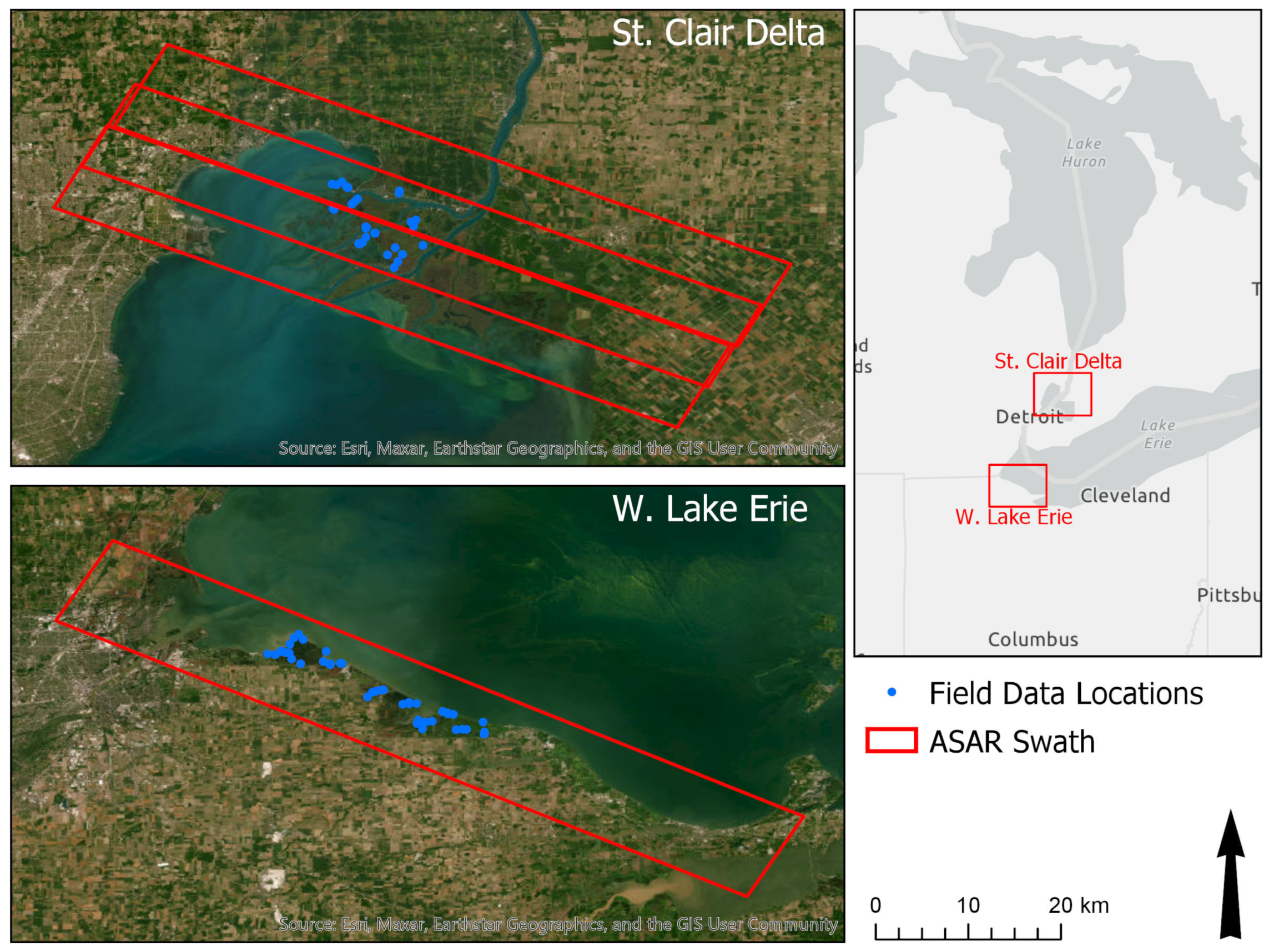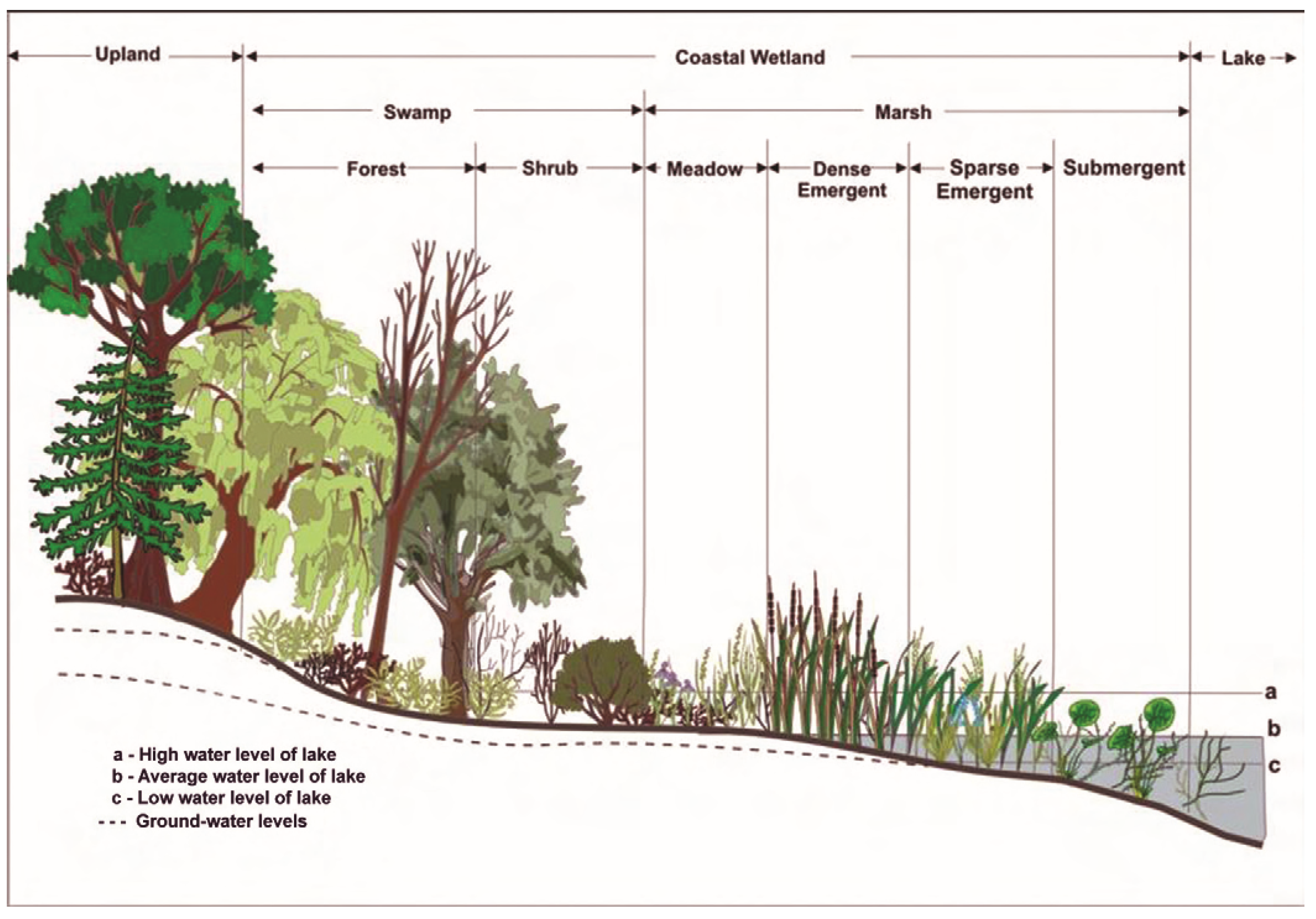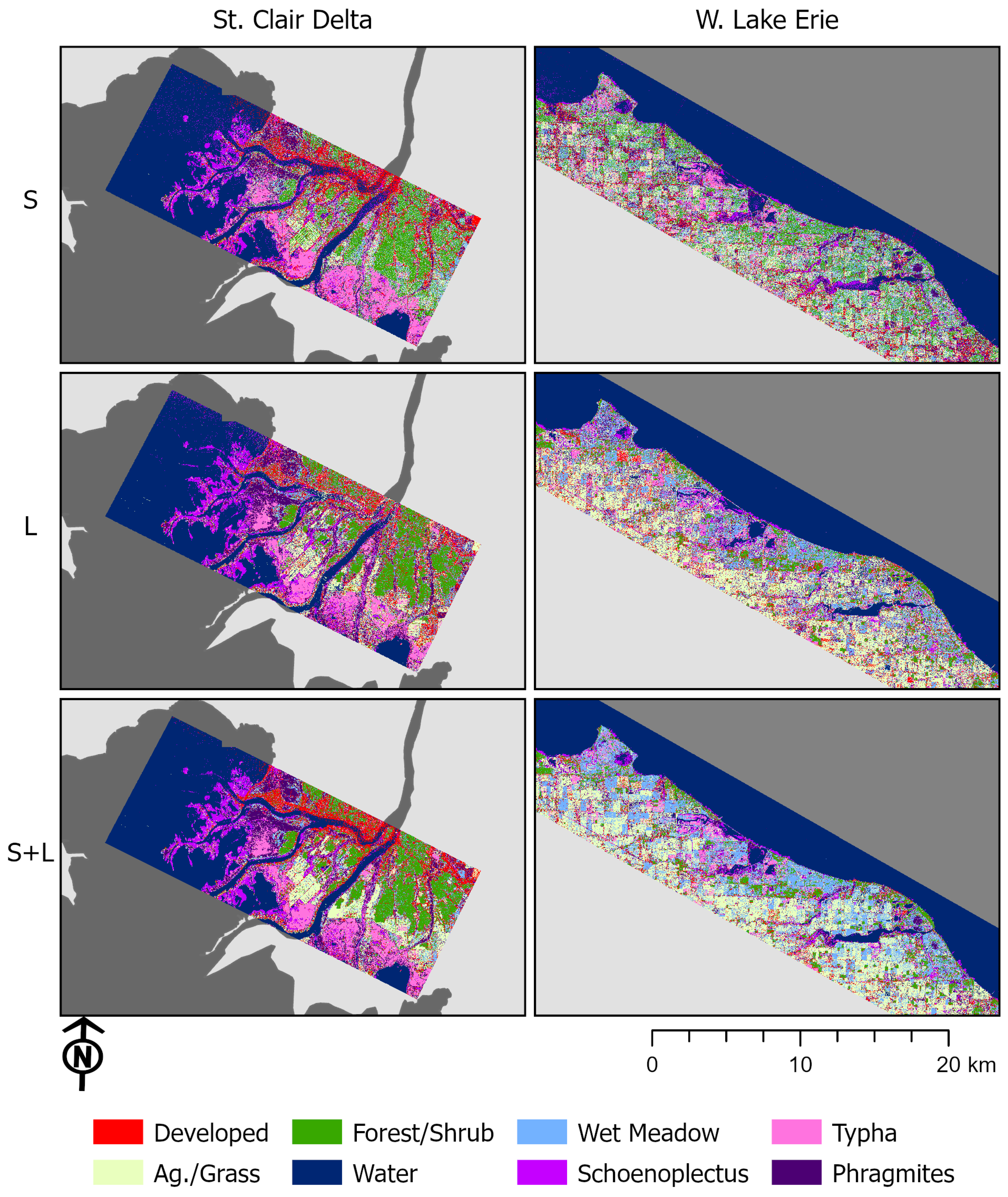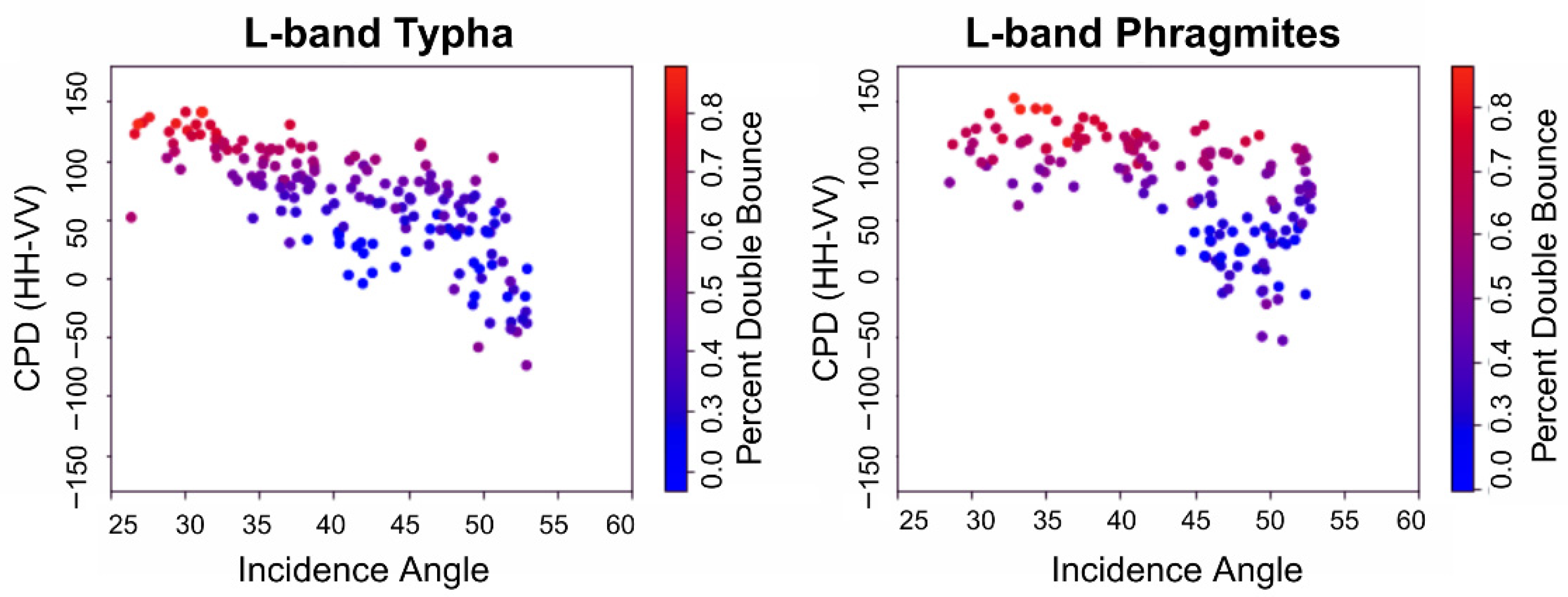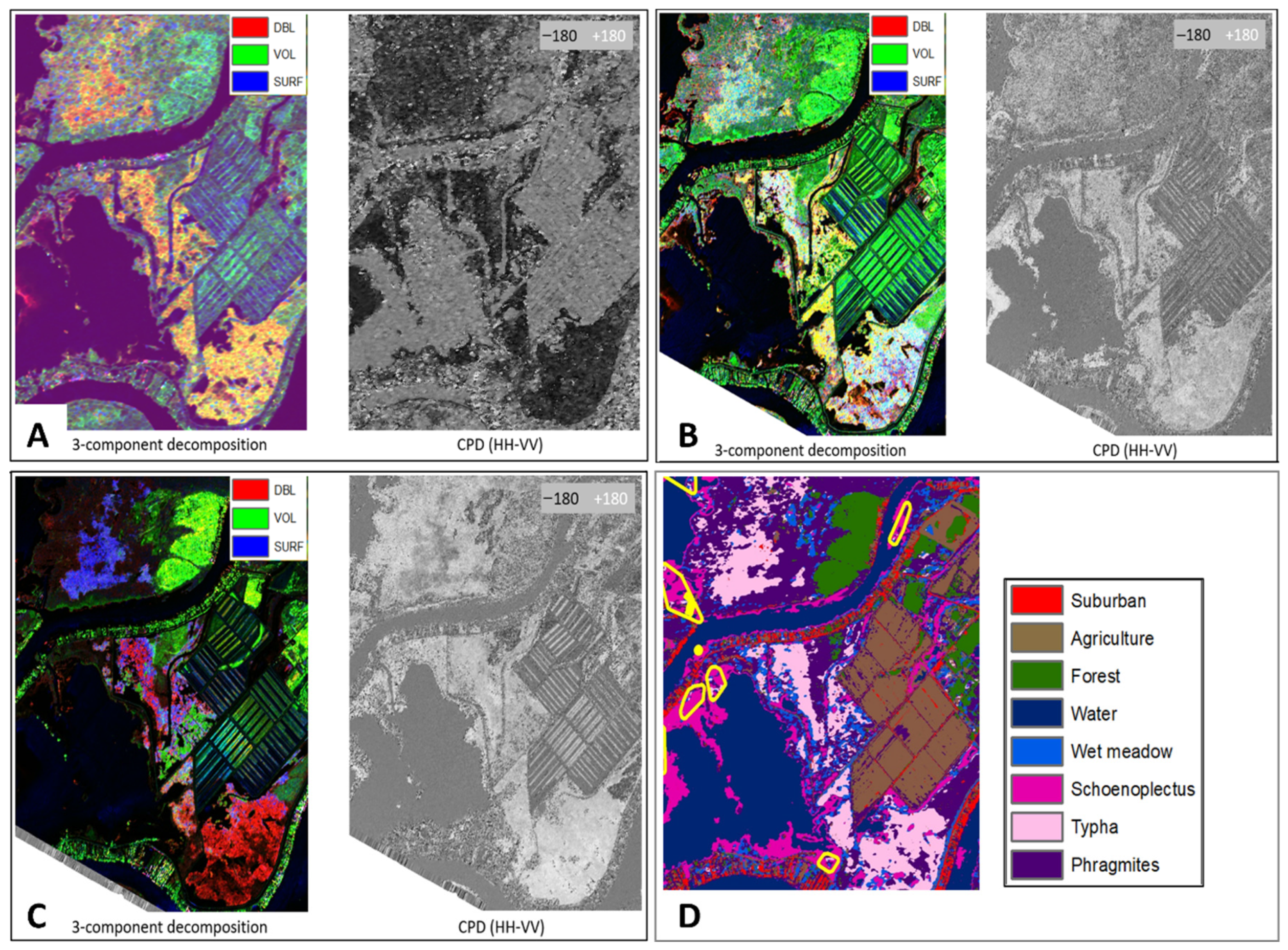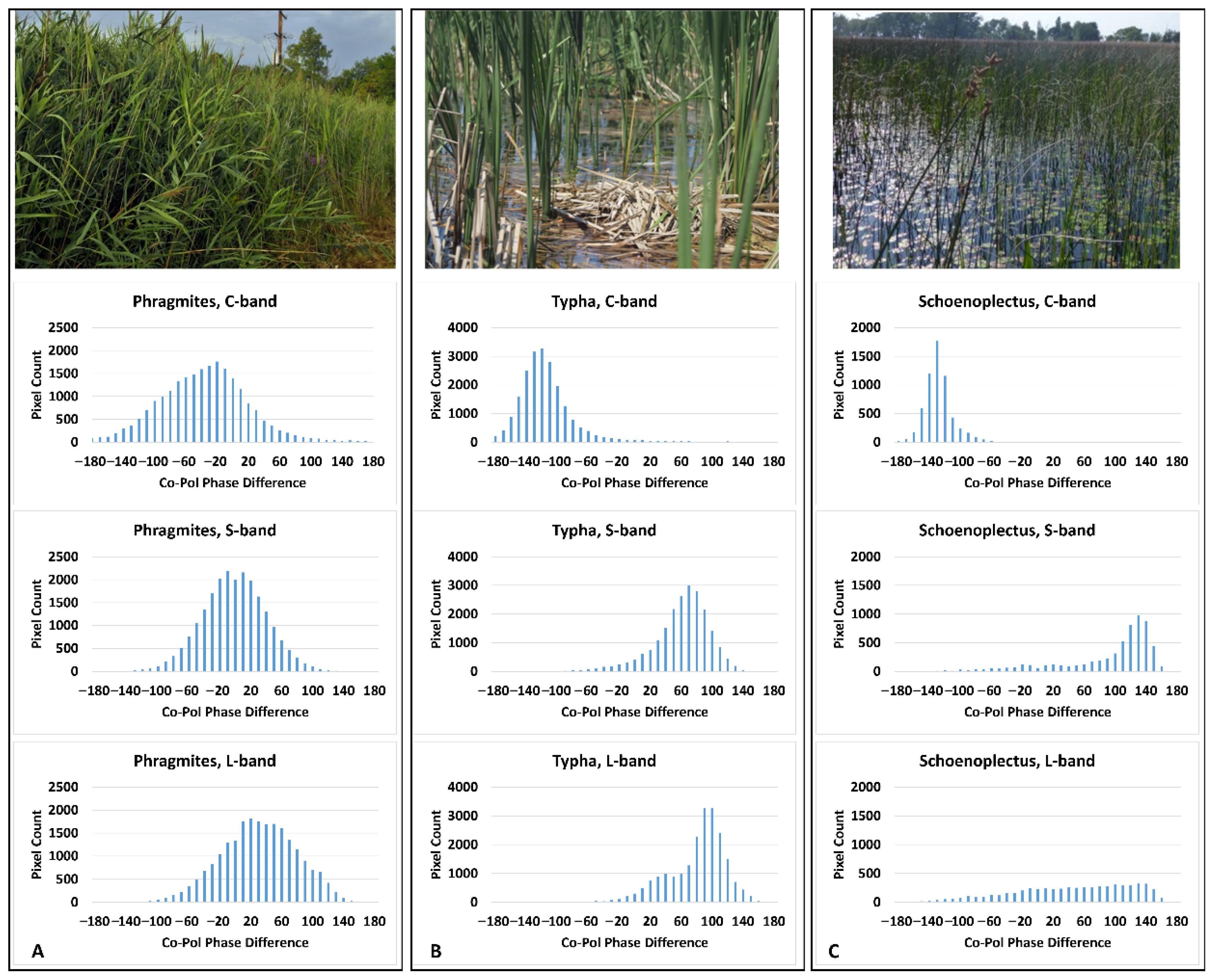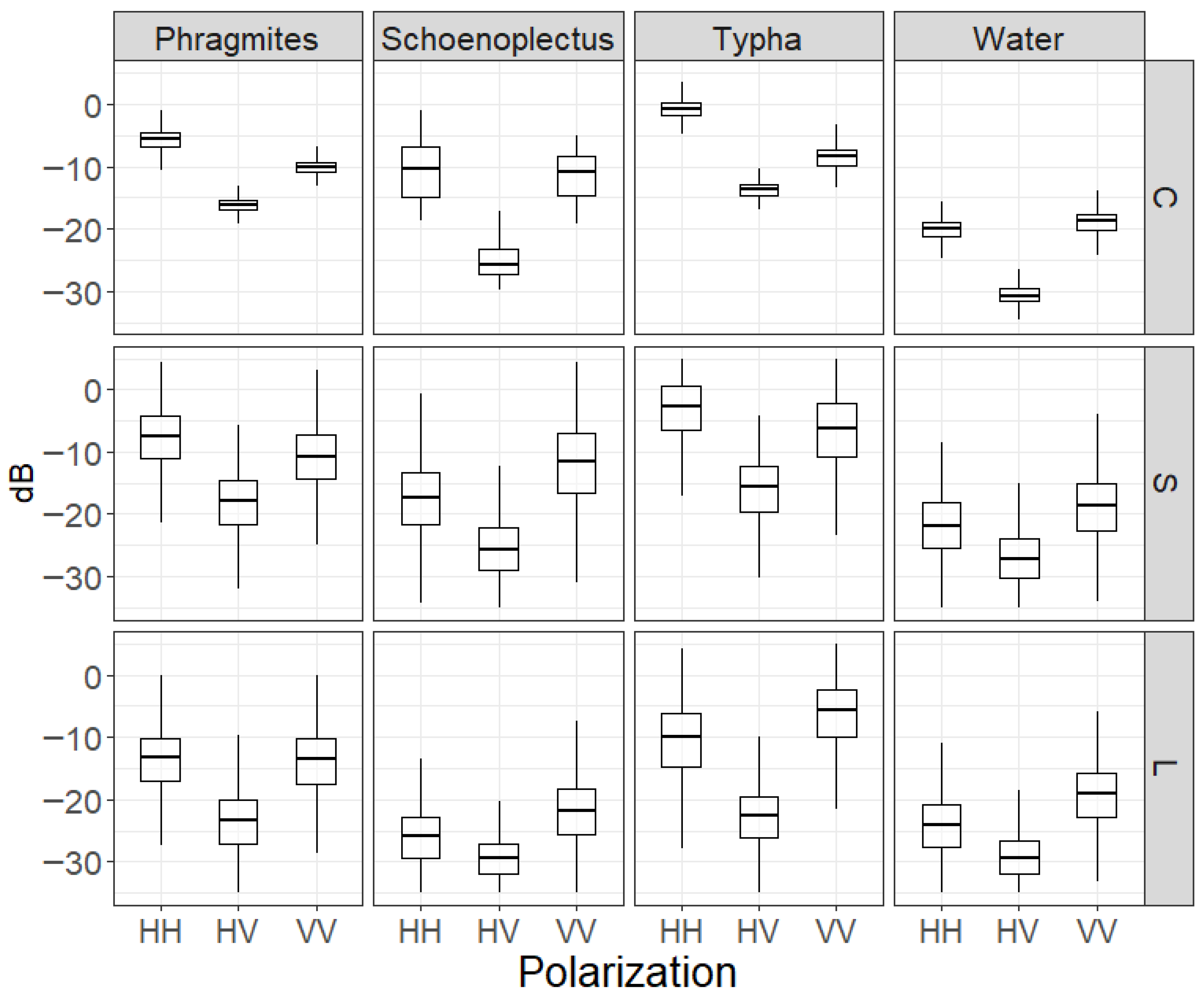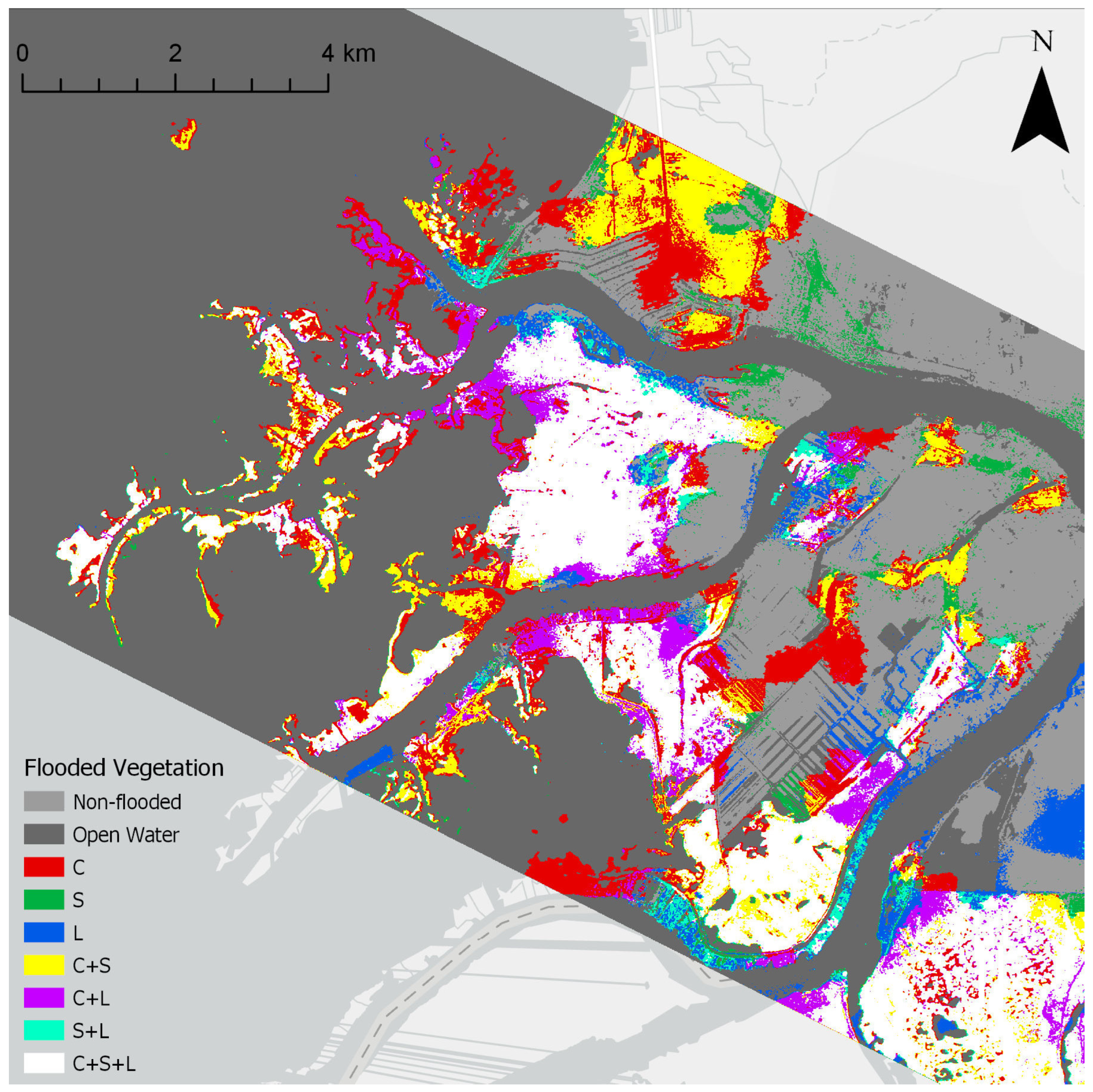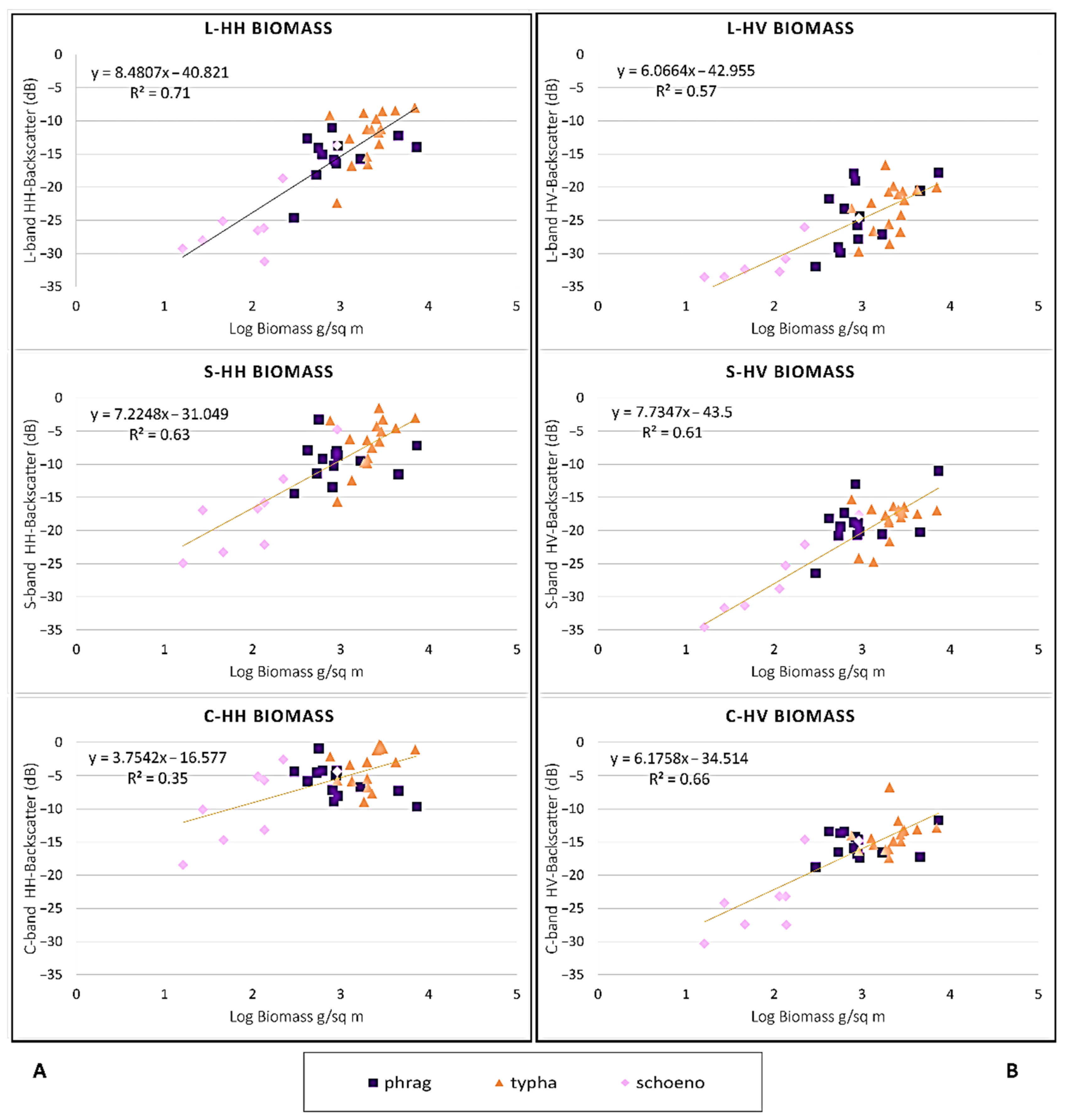1. Introduction
Wetlands act as a crucial interface between land and water, providing natural filtration, flood and erosion control, and a habitat for a multitude of fish, bird, and invertebrate species. Synthetic aperture radar (SAR) sensors are increasingly being used for the monitoring and mapping of wetlands due to their sensitivity to inundation and soil and vegetation moisture as well as their ability to penetrate clouds and vegetation cover (depending on frequency and vegetative biomass). The timing and duration of soil saturation or inundation are key determinants in the flora and fauna that can be found in a given wetland ecosystem. Chemical factors, such as nutrients, pollution, and pH also affect habitat quality and the species that can survive or thrive there. Due to their dynamic nature, wetlands are vulnerable to factors that can alter hydrological patterns, as well as to chemical and land-use disturbances. SAR remote sensing allows for the repeated, broad-scale, all-weather monitoring of wetland ecological health indicators such as type, extent, hydrology and dominant biota. These characteristics provide crucial information for managing wetlands and understanding the effects of climate and land-use change.
The ecological health of the Great Lakes, the largest freshwater system on Earth, which provides drinking water, economic opportunity, and recreation for millions of people, is largely dependent on functioning coastal wetlands. The Coastal Wetland Monitoring Program was established in the Great Lakes to monitor and report on the health of coastal wetlands, largely via routine field sampling of the chemical, physical and biotic environments [
1,
2]. While field monitoring is invaluable, it is time consuming and costly, making repeat observations of the vast Great Lakes Basin challenging. Remote sensing enables routine, synoptic views of regional wetland systems to better understand broad-scale wetland status and trends. When combined with field-based monitoring, it provides land managers with more comprehensive and timely information that can be used to make management decisions.
Great Lakes coastal wetlands are influenced by large lake processes including water-level fluctuations, waves and seiches [
3]. Seasonal water level fluctuations average ~30–40 cm per season [
4]. Longer-term decadal oscillations of >1 m typically occur with a shift in location of the Great Lakes coastal wetlands with lake level lows to highs. However, in recent years, these fluctuations have increased in frequency over short time periods and, in 2018, 2019 and 2020, water levels broke record highs, quickly causing the mass die-off of marsh vegetation, shifting it to open water and drowning previously upland areas; this killed off trees and shrubs, with new emergent wetlands being established in their place. A key question is whether the wetland ecosystems can shift quickly enough and recover when water levels recede (or increase) or whether this may lead to permanent wetland type and habitat losses. Rapid changes to wetland hydrology can have cascading negative effects beyond the loss of wetlands and habitats, including water filtration and flood control. Maintaining coastal resiliency and wetland ecological health from local to basin-wide scales requires knowledge of how these systems are changing, where wetlands are stressed, where there is wetland change, and where habitat is being affected.
Multi-source remote sensing has been used over the previous several decades to provide more regular views of wetland status [
5,
6,
7,
8]. Recent years have seen major advancements due to the increased availability of opensource global data products, such as the European Space Agency’s Copernicus Sentinel-1 C-band SAR and Sentinel-2 multispectral data, along with progress in machine learning and deep learning capabilities e.g., [
9,
10,
11]. In addition, many researchers have improved wetland mapping accuracy by integrating InSAR coherence into their methods, e.g., [
12,
13], and new applications of advanced mathematical models are being explored, such as functional data analysis of seasonal remote sensing trends [
14]. Consistent datasets and routine availability improve the feasibility of wetland monitoring and allow for wetland change and time series analysis.
The use of sensor fusion techniques across multi-seasonal datasets has been a state-of-the-art approach, enabling species-specific mapping of wetland vegetation, which is often assumed to be best detected with hyperspectral data, e.g., [
15]. Using multiple seasons of data allows for the improved discrimination of wetland types by assessing the seasonal variations in phenology related to changes in plant structure and chlorophyll concentrations, as well as seasonal patterns of inundation and soil moisture [
14,
16]. Since the regular and timely application of the established sensor fusion techniques is limited due to cloud cover in the Great Lakes basin (>200 days/year), developing wetland monitoring methods with SAR data alone is desirable. Although polarimetric SAR (polSAR) data have not been widely available, research with C-band polSAR sensors such as RADARSAT-2 has shown that polarimetric derivatives are suitable for mapping wetland types with moderate accuracy from a single image [
17,
18,
19,
20].
C-band has also proven useful for inundation monitoring of marsh ecosystems e.g., [
5,
21], but its ~5.6 cm wavelength has limited vegetation penetration capability, restricting its use to areas with lower biomass, herbaceous marsh, or sparse vegetation. We anticipate that global coverage of NASA-ISRO’s L- and S-band NISAR satellite will greatly enhance wetland monitoring capabilities for marshes and woody wetlands, particularly for the ~24 cm wavelength L-band with its greater penetration capacity and larger dynamic range. When used in combination with the shorter wavelength C-band systems that have been available to date, routine monitoring of most wetland types in the Great Lakes with SAR alone should be feasible. However, the complex interactions between microwave energy and natural wetland vegetation are not yet fully understood, and several anomalies have been reported [
22,
23] that affect inundation detection. The strength of the backscattered signal is strongly dependent on the dielectric properties, structure, and biomass of target vegetation, as well as the inundation condition of the underlying soil; with water under vegetation typically resulting in double-bounce scattering. Recent research focused on understanding the interaction of polarimetric C-band SAR with wetland vegetation has revealed inconsistencies between SAR observations and microwave scattering models [
22,
23,
24,
25] that lead to errors in modeled double-bounce scattering. Such errors can cause significant inaccuracies in estimates of extent of inundation, water level change and wetland status, which rely on the detection of double-bounce conditions (from the smooth water surface and vertical plant stems). Under certain geometric (e.g., incidence angle) and plant moisture conditions, C-VV radar cross section of typical cattail (
Typha spp.) wetlands was found to drop to zero [
24]. VV undergoes two significant dips due to the Brewster angles associated with air/water and air/vegetation interfaces. This is important for environmental applications as most SAR systems dedicated to earth observation have incidence angles ranging from 20 to 50°. This dip for VV at incidence angles below 40° can be problematic. Using Radarsat-2, the three-component decomposition indicated single bounce scattering in some inundated marsh areas, rather than the expected double bounce, despite consistent vegetation and water levels across the marsh stand. Anomalies and limitations of the different frequencies and polarizations for monitoring the various wetlands was an impetus for further research. While ref. [
23] used a simplified model of thin cylinders emerging from a plane of water in physics-based modeling to assess resonance effects at C- and L-band, an empirical dataset was not available for L-band to test the findings in actual SAR imagery at the time.
In this study, we evaluate L- and S-band phase differences and decomposition results for marsh wetlands to determine the incidence angles and vegetation structures at which double bounce is mischaracterized as single bounce. For wetland type mapping with SAR polarimetry, it is important to understand when to expect anomalies in the well-established three-component decompositions (e.g., [
26,
27,
28]), which rely on a threshold of 90 degrees for the co-pol phase difference to classify double-bounce scattering. To complete this evaluation, we used data from the NASA-ISRO airborne system, ASAR. ASAR is a testbed for NASA-ISRO’s L- and S-band NISAR satellite mission, which will provide an unprecedented amount of global data collected every 6–12 days. NISAR will collect fully polarimetric data over the Great Lakes, while most other regions will be collected as dual polarization. The ASAR sensor was flown over a series of study areas including western Lake Erie and the St. Clair Delta in July 2021 [
29] with a coincident field campaign. Canada’s C-band SAR, Radarsat-2, was collected within days of the July ASAR collection, allowing for a direct comparison of C-, L- and S-band SAR over a variety of coastal wetlands representing a range of biomass and wetland types with dry to inundated conditions.
The goal of the present research was to improve our understanding of SAR scattering occurring at L- and S-band wavelengths from a variety of wetland types (emergent, wet meadow, aquatic bed, and invasive species-Typha spp. and Phragmites australis) and hydrological conditions (wet soil to inundation). This understanding should allow for a reduction in errors in wetland detection, mapping of the inundation extent and water level changes and improved accuracies in wetland mapping and monitoring. Three research questions are addressed:
- (1)
Can L-band and S-band polarimetric SAR data be used to map wetland types and differentiate invasive species, such as Phragmites australis, with high accuracy in lieu of optical data?;
- (2)
Do established scattering models explain polarimetric L- and S- band SAR interactions with wetland systems or is anomalous behavior exhibited, as is the case with C- band?;
- (3)
What are the vegetation structure and biomass limitations of different radar wavelengths [L-band (23 cm wavelength) vs. C- (5.7 cm wavelength) or S-band (10 cm wavelength)] in monitoring wetland inundation?
Building on previous C-band research [
5,
22,
23], we use Radarsat-2 polarimetric data as a benchmark of comparison for our ASAR data analysis. We expect that the longer wavelengths will be able to penetrate the denser and higher-biomass vegetation to detect inundation where the shorter wavelengths will be limited. However, the longer wavelengths may not be able to detect sparse plant cover, resulting in specular reflection and misclassification of open water, whereas the shorter wavelengths should be better suited to detecting the presence of sparse vegetation and inundation conditions. Based on previous modeling of scattering behavior [
23], we anticipate that the L- and S-bands will also have anomalies in double-bounce scattering from established decompositions depending on vegetation moisture content, stem size and imaging geometry.
2. Materials and Methods
2.1. Study Area
The study area lies within the coastal wetlands of the Great Lakes Basin (
Figure 1), which are dynamic biophysical systems that are connected to the Great Lakes through linkages of surface water, ground water, or both. Since wetland plants have species-specific adaptations to water depth ranges and seasonality of flooding, a zonation of ecological associations typically forms along the lake shore from deep water to dry land (
Figure 2). Not all zones are present or well-developed in every coastal wetland complex, as variation is contingent on site-specific conditions. These coastal wetlands represent a diverse set of ecosystems ranging from marshes, freshwater estuaries, deltas, lagoons and lake plain prairie to fens, bogs, shrub or treed swamps [
30]. The two wetland complexes (W. Lake Erie and St. Clair Delta) that are a focus of this study are representative of the coastal marsh systems of
Figure 2, with varying water depths and a range of wetland types. These systems are largely diked and managed, as are several coastal wetland complexes in the Great Lakes. They are located in more populated southern regions of the Great Lakes that are subject to excess nutrient loads and land-use pressures and contain invasive plant monocultures of concern.
Throughout the past two centuries, a variety of non-native species have invaded the Great Lakes region. Some of these species are particularly aggressive and problematic. Understanding the current extent of problematic invasive species is critical for management and control, for determining areas at risk from invasion, and for assessing potential impacts on ecosystem services. One particular invasive wetland plant species, Phragmites australis, has been severely damaging to Great Lakes wetlands. Invasive Phragmites exploits rapid water level changes and quickly takes over vast areas of exposed habitat, outcompeting native species and forming dense, nearly impenetrable, tall (up to 5 m) monocultures that reduce wildlife habitat, displace native vegetation and obscure views of the lake. Coastal wetlands of the southern Great Lakes are particularly affected by invasive Phragmites as well as invasive cattail (Typha angustifolia) and a hybrid (Typha × glauca) between the native (Typha latifolia) and invasive species.
Typha, Phragmites, as well as bulrush (Schoenoplectus acutus) often form large monocultures in the coastal wetlands that are important to distinguish in mapping wetland types and for monitoring in the shifting zonations. Hereafter, we refer to these monoculture species by their genera. Since these three species form extensive areas in our study areas, much of our research is focused on them.
Typha is described as a stout stemmed emergent wetland species, often growing in dense clumps. It has broad linear leaf blades and a distinguishable brown cylindrical flowering spike.
Phragmites is a perennial grass, with a stiff thin central stem and many wide leaves forming along the length of the central stem. The plumy inflorescence at the top of the stems often has a purplish hue.
Schoenoplectus is a sedge known as bulrush with a thin (~1–2 cm diameter) cylindrical mainstem 1–3 m tall, typically growing in deeper water than
Phragmites and
Typha, up to 1.5 m [
32]. However, plants as tall as 4.2 m have been found in even deeper water [
33]. The only leaves are small and near the base of the plant. The inflorescence forms in a terminal panicle at the end of the stem but appears to come from the side of the stem.
Schoenoplectus,
Phragmites and
Typha are all clonal through rhizomatous root systems and often form monocultures. There is a general trend of increasing density, height, and biomass in these species (
Figure 3).
The two study locations are heavily diked for wetland management and, in July 2021, much of the Lake Erie wetlands inside the dikes were under a drawdown of water, leaving many with atypical low or no standing water. The St. Clair Delta had typical water level conditions for the wetland complexes.
2.2. Field Data Collection Methods
Field data were collected in support of the ASAR mission from a variety of field locations coincident to the overpasses in the St. Clair River Delta and wetlands of western Lake Erie. Field data on the extent of inundation, water levels, height, density and biomass of different wetland vegetation types, canopy closure, and other wetland characteristics were sampled to assist us in interpreting the signatures of L-, S- and C-band radar data to address our research questions. A total of 46 field sites were sampled, with 31 sites in the St. Clair delta ASAR footprint and 15 sites in the Western Lake Erie footprint (
Table 1) including 9
Schoenoplectus dominated sites, 16
Phragmites dominated sites and 22
Typha dominated sites.
Field locations in the St. Clair River Delta and Western Lake Erie were visited the week of 14 July of 2021. Using 2019 base maps produced from 3 dates of Radarsat-2 PolSAR data and 3 dates of WorldView-2 imagery [
5,
34], we randomly selected field locations across the study area within 1 km from access points via a road or water body (via boats). Each site was at least 20 m × 20 m in size and of a fairly homogeneous ecosystem type to be commensurate with the resolution of the SAR systems and account for speckle reduction. At each site, the general wetland type was recorded (shrub, emergent, open water, upland, floating aquatic), as were the percent cover of vegetation, open water, exposed soil, and dominant and sub-dominant species present. For the monoculture sites of
Phragmites,
Schoenoplectus and
Typha, we sub-sampled three 30 cm × 30 cm subplots that were randomly selected for measuring the number of stems by species separated by live and dead condition. Of these stems, 3 representative live individuals were measured for stem height, basal diameter, diameter at water level, and diameter at 1 m height above water along with water depth with a date/time and GPS stamp. Notes on whether vegetation was tilted from wind or fallen/knocked down were made, as well as insect damage, herbicide, or cut vegetation. As part of the protocol, GPS tagged photos were taken at each site center, in four cardinal directions, nadir and straight up. Vegetation biomass data were acquired at 27 sites in the St. Clair River Delta and 15 sites in the wetlands of western Lake Erie. Additional data were collected in wetlands without the presence of the three types of interest (
Figure 1).
For biomass estimation, unpublished allometric equations were used from the University of Michigan’s database for Schoenoplectus and Typha. For Phragmites, no equations existed, so we harvested Phragmites stems from 2 locations (20 stems) and developed a new biomass equation based on height of vegetation.
Phragmites biomass, where
is height in m:
Schoenoplectus biomass, where
is height in cm:
Typha biomass, where
is volume in cm
3:
Mean height of vegetation ranged from 1.36 to 2.89 m, live biomass ranged from 16.2 to 7336.5 g/m
2, and dead standing biomass from 0.0 to 9755.4 g/m
2 (
Table 1).
2.3. Remote Sensing Data Processing
ASAR data collected on 14 July 2021 over the Great Lakes study areas were distributed as Level 1 Single Look Complex (SLC) data and Level 2 Geocoded Amplitude Images. We downloaded Version 1.3B Level 1 and Level 2 data from NASA’s JPL website (
https://uavsar.jpl.nasa.gov/cgi-bin/asar-data.pl (accessed on 23 October 2023)). Level 2 data were calibrated to Sigma Nought (
) intensity using the following calibration algorithm:
where
represents pixel values in the provided GeoTIFFs,
is the local incidence angle (provided as an ancillary dataset),
is the noise bias for each polarization, and
is the calibration constant. Noise bias and calibration constants were provided in associated metadata. Although the product was geocoded, there were some geolocation errors, so additional manual georeferencing was applied by visually interpreting tie points between the SAR data and high-resolution optical airphotos. For this process, we utilized USDA NAIP images collected in 2020 and 2021.
For polarimetric data analysis, we extracted SLC data from the provided HDF5 files and used PolSARpro software (v. 6.0) to apply a Refined Lee Polarimetric Filter with a 7 × 7 pixel window size to both L- and S-band data. Three polarimetric decompositions were applied to the quad polarized data. First was the van Zyl et al. [
26] non-negative eigenvalue decomposition (NNED), similar to the Freeman and Durden [
28] decomposition but with correction for overestimation of volume scatter, which leads to the misattribution of scattering power in the model. This model produces double-, volume and single-bounce scattering. Second was the Cloude and Pottier [
35] decomposition that produces Entropy, Anisotropy and Alpha Angle parameters. H is a measure of a mix of three orthogonal scattering vectors. H = 0 implies a pure target with a single dominant scattering vector. H = 1 implies equality of all scattering vectors. Anisotropy provides the relative importance of the second and third scatters. Alpha provides the mean or dominant scattering mechanism (when H is close to 0, 0° α = single bounce, 45° α = oriented dipole, and 90° α = double bounce). Last was a decomposition specifically designed for vegetation mapping: the Neumann et al. [
36] decomposition, which produces three polarimetric parameters: Delta, Tau, and Delta Phase. Moreover, ref. [
36] uses a generalized volume scattering model to describe the morphological vegetation traits; the particle scattering anisotropy (Delta) and the degree of orientation randomness (Tau). The third parameter, the phase of the particle scattering anisotropy (Delta phase), is related to the particle orientation direction. Tau is an indicator of the degree of scattering randomness, similar to Cloude Pottier’s H. Georeferencing information extracted from the HDF5 files was used to geocode the polarimetric results. Like the Level 2 products, manual georeferencing was required to ensure geolocational accuracy of the output data.
For C-band Radarsat-2 (R-2), FQ10W data over Lake St. Clair and FQ62 over western Lake Erie were acquired on 26 July 2021, under a USFWS cooperative agreement. SLC data were provided for the quad-pol imagery and similar processing was performed as the L- and S-band; however, for R-2 data, both PCI and PolSARpro were used, applying radiometric terrain correction in PCI. In this case, post-processing geolocation with tie points was not necessary.
2.4. Wetland Type Mapping
Polarimetric decomposition components for S- and L-bands were used as inputs in a Random Forests [
37] classifier, which has proven effective with the L-band [
38]. Training and validation data for the model were derived from a combination of field data and interpretation of USDA NAIP aerial imagery. Then, 80% of training polygons were randomly selected for training and the remaining 20% were reserved as an independent validation dataset. The model was run in a Python 3.0 environment using the Sci-kit Learn package. The model was initiated with default parameters except for the number of trees, which was set to 500.
We use 2019 wetland type maps produced from multi-date high resolution digital globe worldview imagery and Radarsat-2 polarimetric data (R-2/WV) [
5,
34] as benchmarks to compare L- and S-band SAR-based wetland type maps in our study.
2.5. Assessment of Scattering Models
To assess the accuracy of established scattering models, we generated additional polygons representing 10 m × 10 m areas of Typha and Phragmites across a range of incidence angles from the Lake St. Clair dataset. We then extracted mean local incidence angle and the mean of each scattering type from the van Zyl NNED decomposition products to compare expected vs. observed scattering behavior.
We created co-pol phase difference histograms of the three dominant wetland monocultures, using 2019 multi-date Radarsat-2 and Worldview basemaps [
5,
34] to determine the extent of each across the St. Clair River Delta ASAR images. These were produced similarly to [
22,
23] and allow us to assess the dominant scattering type occurring via the expected co-pol phase difference (CPD). Single-bounce scatter ideally (in the absence of noise) has an expected CPD of 0°, double-bounce scattering has an expected CPD of 180°, while volume scatter has an expected uniform distribution from CPD −180° to 180°.
2.6. Assessment of Vegetation Structure Limitations
To assess how vegetation structure and biomass limited our ability to monitor inundation, we applied a thresholding method to distinguish flooded vegetation from open water and non-inundated areas. The method involves analyzing the histogram of cross-polarized backscatter to separate open water from land and flooded vegetation via Otsu-thresholding [
5]. Specular reflection from water typically results in a strong bimodal distribution, so areas less than the threshold value are classified as water while areas greater than the threshold value are classified as land or flooded vegetation. The cross-polarized ratio (HH/VH or VV/VH) was used to distinguish flooded vegetation from non-flooded vegetation within areas not initially classified as water. Otsu thresholding was applied to the histogram of the cross-polarized ratio to distinguish flooded vegetation (pixels greater than the threshold value) from non-flooded vegetation (pixels less than the threshold value). In this case, we incorporated both VV/VH and HH/HV to quantify the flooded vegetation extent with pixels identified as being over the threshold value in either ratio being classified as flooded vegetation. We also assessed the relationship between total live and dead biomass and backscatter from the different frequencies and polarizations to determine which had strong relationships to biomass and whether developing biomass retrieval algorithms for wetlands in the Great Lakes was feasible.
4. Discussion and Limitations
One of the most accurate methods of producing wetland type maps is using a combination of radar and optical multi-season data [
16,
39]. This allows for the capture of phenological differences in the wetland types from spring, summer and fall, as well as differences in structure and inundation conditions from radar. We found that fully polarimetric S- and L-band SAR data from a single date can be used to effectively identify the extent of various wetland plant genera and wetland types common in the southern Great Lakes without the use of other data sources, such as optical or thermal imagery. This has a significant advantage for timely mapping in locations such as the Great Lakes, which are often cloud covered. The overall accuracy of our wetland type map, created with combined L- and S- band data and machine learning classifiers, was approximately 92% for the St. Clair Delta. This is comparable to accuracy estimates achieved with combinations of three-season optical and C-band SAR imagery [
5]. Other researchers have had success in mapping wetland marsh with single date C-band [
19] and L- and C-band [
20] polSAR decompositions using machine learning and deep learning classifiers. Fu et al. 2023 [
20] found the L-band to outperform C-band and decompositions to outperform backscatter coefficients in their deep learning algorithms with the best overall accuracies of 86–88%. C-band polSAR decompositions were found to be suitable for mapping a wetland area in China where there were only two wetland types, and both had very low stature biomass herbaceous vegetation (
Suaeda salsa and
Spartina alterniflora) [
19]. They found the C-band decompositions to allow classifications with overall accuracies of 78 to 93 percent and wetland type class accuracies between 63 and 94 percent, depending on the model.
Our results showed lower accuracies in L- and S-band SAR mapping in the Western Lake Erie study area, which is likely due to the non-flooded condition of wetlands. Many of the major wetland complexes in the region are diked with artificially manipulated water levels. During the period of the ASAR data collection, many of these Lake Erie areas had been drawn down to very low or zero water levels. This observation indicates that inundation status is a key factor in the ability to accurately identify wetland monocultures in the Great Lakes from a single date of polSAR imagery. Scattering signatures are more differentiable under flooded conditions due to double-bounce scattering from the water and vegetation. In non-flooded conditions, double-bounce scattering is greatly reduced and single-bounce or volume scatter prevails. This results in confusion with upland classes of similar vegetation structure. This is highlighted by the relatively low accuracies of non-flooded cover types in both study areas, namely, the agriculture/grass class, which was often confused with the wet meadow class. Wet meadows tend to have wet or saturated soils, but water tables mid-summer, when the ASAR were collected, are typically below the surface. Since agricultural areas are often irrigated in the Great Lakes and are also monocultures, the confusion with wet meadow is unsurprising. Similarly, the developed class had low accuracies. In the St. Clair Delta, there was often confusion between the developed class with wetland type classes, particularly Phragmites. In W. Lake Erie, the developed class was confused with several classes. This result is likely due to the large in-class variability of the area, with heavy industrial activity and urban environments in and near Toledo, and extensive low-density residential areas throughout the region that cause double bounce from the human-built structures. The high accuracies achieved for Schoenoplectus with L-band data were somewhat surprising considering the often sparse distribution of Schoenoplectus stems. It is important to note that only two sites with Schoenoplectus were visited in the W. Lake Erie study area, so additional patches were identified with the interpretation of high-resolution aerial imagery. Although the aerial imagery was collected during the same summer as the ASAR overpasses, they were not coincident, so there is a possibility that some Schoenoplectus training samples were not representative of the class and instead were more representative of open water, which would explain the confusion in the classified maps. However, double bounce from wind-drawn capillary waves could also be a cause of confusion.
Common decomposition methods are prone to misidentifying the dominant double-bounce scattering type as single-bounce scatter under certain vegetation moisture and SAR geometry conditions. Our analysis shows that this misattribution occurs at S- and L-bands, similar to previous research at the C-band [
23,
24]. The observed scattering behavior related to the incidence angle (
Figure 5 and
Figure 6) and vegetation structure (
Figure 7) was generally consistent with published models of microwave scattering from dielectric cylinders [
23,
24]. When the anomaly will occur is a function of the radius of the vegetation stems (i.e., cylinders) relative to the wavelength [
24] and the moisture in the plants. While the three-component decompositions are popular, they should be considered with caution, since we observed a lack of double bounce in the near and far ranges, depending on frequency and vegetation. It is better to use CPD without a static threshold, and a range of decomposition and backscatter information to inform inundation conditions and wetland type mapping.
Low moisture in the vegetation results in larger anomalies [
24]. Using a time-series of NISAR data may allow for the monitoring of wetland plants for moisture status by using the appearance of these anomalies, such as during the onset of senescence in the fall season, or when the vegetation becomes stressed during drought or other circumstances that cause water level changes.
Our results showed that detection of flooding beneath the three dominant species that often form monocultures (
Phragmites australis,
Schoenoplectus acutus, and
Typha spp.) was dependent on frequency in relation to the biomass and structure of the vegetation (
Figure 9,
Table 4). C-band, the shortest wavelength studied, performed best for detecting flooded
Schoenoplectus which has the sparsest and simplest structure. L- and S-bands were able to detect flooding beneath the high-biomass, dense
Phragmites canopies, whereas the C-band was limited, similar to previous findings with C- and L-bands [
40]. Lamb et al. 2025 [
40] found L-band backscatter thresholding to work well in mapping inundation in coastal salt marshes with varying marsh vegetation including
Phragmites australis,
Typha spp.,
Spartina and
Schoenoplectus, with accuracies around 90% or better for L-HH or L-VV. They found limitations in C-VV backscatter thresholding from Sentinel-1 and suggest for C-VV data that it is best to use change detection classification from different tidal stages which produced higher accuracy (76%) maps. Radiometric modeling conducted by those authors [
40] demonstrated that C-HH (as available from Radarsat-2) is more sensitive to inundation and surface changes than VV polarization (i.e., Sentinel-1). We found that all three frequencies studied (L, S, and C) were able to detect flooding beneath
Typha canopies and immature
Phragmites stands. Thus, a single-frequency system is going to have errors due to a mismatch of wavelength to vegetation stem size, density, height and biomass. We suggest that a combination of frequencies would be optimal for monitoring inundation extent to capture flooding beneath a range of canopy types and vegetation structures, across a range of incidence angles.
Last, for the flooded marsh wetlands, we found that we could produce a biomass retrieval algorithm from the SAR polarized data, with the strongest relationship for L-HH (R
2 = 0.71), followed by C-HV (R = 0.66) and S-HH (R
2 = 0.63). This is important for monitoring changes in plant biomass over a growing season and, in combination with wetland type maps, would allow for assessing wildlife habitat and nesting grounds. Furthermore, it is important for estimating C-storage in wetland vegetation and for National Greenhouse Gas Inventories [
41].
It should be noted that a polarimetric signature analysis of ASAR co-pol and cross-pol channels for both L- and S-band by [
42] showed that perfect behavior is exhibited by the co-pol signature, but distortions were easily identified in the cross-pol signatures. The distortions identified by [
42] may impact polSAR decompositions, with either under- or overestimation of scattering elements. Since these over- or underestimations of scattering elements may be dependent on wetland cover type, it did not seem to adversely affect our ability to map wetland types. Due to the identified distortions in the cross-pol, our phase difference analysis only included the co-polarized data, which allowed us to assess dominant scattering mechanisms and relate them to the three component modeled decompositions.
There were limitations in our field data set that should be expanded for further analyses. Observations of wetland sites with non-inundated wet soil conditions were limited and should be explored further. We found that the SAR biomass retrieval algorithms had higher accuracies when the non-inundated wetlands were withheld; however, the number of non-inundated wetlands sampled was low, preventing a similar analysis for non-inundated wetland biomass retrievals. In addition, limited shrub wetlands were sampled in the field and there was a lack of samples for forested wetlands. SAR monitoring limitations in woody wetlands need to be further explored and the threshold classification technique for marsh vegetation is likely not suitable for forested wetlands; instead, a change detection approach may be necessary [
40].
5. Conclusions
High-temporal-resolution multi-frequency (e.g., L-, S- and C-band) SAR dual polarization and quad polarization data will greatly improve the capabilities of mapping wetland types and monitoring hydrological conditions, regardless of cloud cover conditions during key periods of importance, e.g., during important breeding or nesting habitat seasons, which can be of very short duration. The additional knowledge gained from routine 6–12-day repeat NISAR collections will improve coastal wetland monitoring capabilities, which is of key importance as water level fluctuations and invasive species encroachment continue to alter the land–water interface. Monitoring information will be important for management decisions in areas with significant human populations, areas vital for wildlife habitat conservation or restoration and for planning for coastal resiliency. In addition, routine monitoring of wetland extent changes over time will allow for the detection of wetlands connected to the Great Lakes via surface and ground water. This is important because connectivity to the Great Lakes defines coastal wetlands, which are affected by large lake processes and regulated differently than non-coastal wetlands.
In this study, we confirmed the anomalous behavior of scattering and decompositions at the L-, S- and C-bands, which explain errors that may occur in inundation and classification mapping. Such model inaccuracies have implications for repeat-pass InSAR applications for water level changes, which requires high coherence between successive image dates. Ahern et al. [
5] recommend choosing radar wavelengths that are considerably shorter, or longer, than the diameters of the wetland plant stems of interest to avoid resonance effects in double-bounce backscatter. The anomaly can appear as “holes” in the imagery due to large drops in backscatter, or changes in the dominant scattering mechanism. The plant structure (diameters, heights and density) also restricts which frequency will have penetration limitations or fail to detect vegetation presence. We analyzed three dominant genera found in the southern Great Lakes, which varied in typical size structure. While we cannot give specific thresholds for plant structure limitations with the limited dataset we observed, we provide our results with reference to the typical plant structure for the three dominant genera of our study area as a reference. For
Typha, stem diameters averaged around 1.6 cm and were the largest diameters of the three dominant genera. This diameter is considerably smaller than C-, L- and S-band wavelengths, and the mean height was approximately 1.8 to 2.2 m and density 20–28 stems per sq m. This vegetation structure allowed inundation to be mapped in all three wavelengths. For
Schoenoplectus, the mean stem diameter was approximately 0.80 cm, with densities of 13.8 to 195 stems per sq m and heights averaging 1.4 to 1.96 m. These wetland stands were the shortest and smallest in diameter of the three wetland genera. Inundation in
Schoenoplectus was detected by C- and S-bands, but was limited at L-band, even in dense stands of Lake Erie. The stems of
Schoenoplectus are too small to be detected by the L-band. For
Phragmites, which differ from the other two genera in that they have central stems with leaves alternating the full length of the stem, they had mean stem diameters of 0.81 to 1.04 but were the tallest (mean 2.05 to 2.89 m) and dense (38 to 44 mean stems per sq m). Biomass was by far the greatest in the
Phragmites (mean 1083 to 2667 g/sq m) and volume scatter dominated for C- and S-bands, with limited detections of inundation. Only the L-band showed dominance of double-bounce scatter in the three-component decomposition and allowed for more reliable inundation detection. For all of these genera, there are incidence angle limitations, and incidence angles shallower than 35° have higher uncertainty in inundation detection capability.
While C-band data have been routinely available from Sentinel-1 since 2015, they are limited to dual polarization (VV/VH) with penetration limitations in higher-biomass wetlands. NISAR is planned to collect quadrature polarization over the Great Lakes, allowing for the continuation of many of the methods developed in this research to be used for monitoring. S-band data will not be available over this region, but combining Sentinel-1 and or quad polarization RCM or Radarsat-2 with NISAR L-band will provide powerful tools for monitoring the wetland ecological health of the Great Lakes for the range of marsh ecosystems that exist, as well as for woody wetlands.
This study provides an advancement in understanding of polarimetric SAR for studying wetlands and understanding frequency and incidence angle limitations, as well as traditional three-component decomposition model inaccuracies. This improved understanding of SAR limitations in wetland monitoring will allow for the improved design of approaches for mapping wetland extent, wetland type, water level changes, wetland biomass and wetland contributions to carbon cycling.
